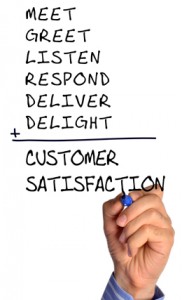Last weekend, I traveled to the Waldorf Astoria Orlando for the wedding of one of my closest childhood friends. I had booked round-trip transportation to and from the airport and, when my return shuttle never arrived, I immediately assumed I’d be on my own. After briefly explaining my situation to the hotel concierge, she stepped out from behind the desk, whispered something to a bellhop and – in a matter of minutes – something amazing  happened.
happened.
I was whisked to a side parking lot, where a uniformed chauffer and town car just happened to be waiting. Before I knew it, I was on my way to Orlando International Airport, a cooler of refreshing beverages at my feet and my personal choice of music on the stereo. No questions were asked; no extra fees were charged. I thought: “This one of the best examples of customer service I have ever witnessed.”
The experience got me to thinking about the art of customer service , especially as it relates to field of public relations. As a PR agency, Buchanan PR is typically sought after by clients who value our input and view us as collaborative partners in the development and execution of their communications strategies. In return, we tend to espouse the mantra: “The client is always right.” If the language we’re using in a boilerplate seems off on first reading, we try again. If a client doesn’t like the website copy we’ve drafted, we immediately get to work on a second draft. Usually, with a little back and forth, we get to a place where everyone is happy with the message we’re articulating.
However, many in our industry argue that it is routinely necessary to “push back” on clients. After nearly 15 years in the profession, I have a slightly different view. Although much is written about psychology and personal dynamics in PR, we should all stop now and again to think about the role of customer service. After all, we are being hired and paid by our clients – the ones who have laser-focused insight into how their businesses run, who their audiences are and what images they want to portray – to aid in message development.
But what about those instances when it’s clear that agency and client have are headed in two completely different directions? If there comes a point where we need to educate a client about how and why a strategy they suggested isn’t working, shouldn’t we try to do it clearly and succinctly, but with a definite touch of humility? After all, the best leaders I know use graciousness and tact – not bulldozing and arrogance – to make their voices heard. In PR especially, it’s all about the art of the compromise. I’ve found this to be the best , and most successful , way to build the client-agency relationship, not to mention foster an environment of teamwork, honesty and trust.
I shudder to think what might have happened had I gone into a rant about my airline shuttle experience in the heat of the moment. Would the hotel concierge have been as accommodating? Something tells me I wouldn’t be sitting in a chauffeured car, listening to Bob Marley and sipping an ice-cold bottle of water like the whole thing had never happened. Perhaps we should all keep this in mind when we contemplate the art of customer service as it intersects with the public relations profession.
Agreed. There is a delicate balance between giving clients what they want and also consulting them to be better than perhaps they thought they can be. Yes, clients know their industries better than we do. But at the same time, we likely know the media and communication better, and know how to develop positioning that will stick with these audiences.
I like to go for the, “Sure, we can do it that way. But did you consider this?” approach. Deliver your argument (or “push back”)calmly and professionally, offer examples when possible, and do your best to educate the client on the logistics, outcomes, unknowns of what they are deciding. Depending on how well your message is received, maybe try one more time. But after that, work on that compromise!
More often than not, clients appreciate the additional viewpoint and guidance, even if they don’t agree with it.
You make some great points, Denise. As PR strategists, the ideal relationship we’re trying to establish with our clients is one of “trusted adviser.”
To that end, the “how you say it” can be just as important as the “what you say.”
Providing real-world examples and actively listening to clients are key ways to reach mutual understanding in the case of diverging viewpoints.